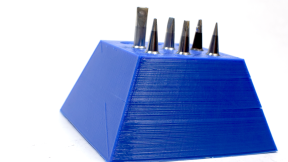In the context of more-than-human design, non-human actors like physical materials are foregrounded as active participants in the design process. While material origins have been examined, understanding how design technology to foreground these relationships is overlooked.This paper explores the practice of clay foraging, where ceramicists source and process wild clays from their environment, as an exemplary model of cultivating a profound material connection. Through material-participant observation during clay foraging, we identify themes in material relationships, revealing clay as a reactive material whose properties are significantly influenced by its treatment. The painstaking process of making clay suitable for forms uncovers a deep material relationship. Using speculative...
Student Projects

In recent decades, ontologies have become valuable tools for sharing and understanding domain-specific knowledge. Large Language Models (LLMs) have simplified the process of creating these ontologies by assisting in generating competency questions (CQs), enumerating concepts, and forming class hierarchies. However, their application to skill ontologies remains underexplored. This paper explores using LLMs to develop skill ontologies in digital fabrication, specifically laser cutting. We propose an iterative method for developing a laser cutting skill ontology, consisting of three phases: ideation, refinement, and validation. In the ideation phase, we generate CQs, concepts, and skills using various prompting techniques. During refinement, we link skills and form hierarchies. In...

The programming process of shape memory alloys (SMAs), where the "memorized shape" of SMA is changed, presents many challenges and limitations. Possible programmable SMA geometries can be created using custom using custom direct energy deposition 3D metal printed programming jigs. Different wire and cable manipulation techniques can also create stronger and more precise geometries.

This research addresses ways to improving trust and privacy through data physicalization based on cookies from the site your on by employing a physical attention grabber device that interacts with the user that does not become repetitive, annoying,and familiar to inform them if a site is at risk of breaching their private information. The importance of informing and notifying users of the reality of fake sites (phishing), is keeping them notified in a physical way that uses one or more multiple stimuli.People don't know what it means when they press accept all cookies that could lead to breach of private information that could lead to identity theft and credit fraud.This work benefits a very wide range from young to old.Since people use computers and put their private information in...

In the world of materials science, many are developing nanomaterial composites to simulate human skin, bone, and organs. Conductive soft materials are a hit for trying to simulate biomaterials, however many different materials could be used such as silicone elastomers with conductive fillers. There is a need to determine a better way to navigate through the fabrication process by identifying the best dispersion/mixing technique for fabrication of the conductive skin like bio materials. This research combines two different dispersion methods, hand mixing (with power tool), and ultrasonic homogeneous mixer with conductive materials like copper powder, graphite powder, and chopped carbon fiber. We investigate how different fabrication techniques affect the dispersion by looking at how...

Researchers have sought to detect changes in pressure within different segments of soft robotics to enable tasks such as picking up irregularly shaped objects. Traditional distributed tactile sensing (DTS) systems typically require extensive sensor arrays or complex multimaterial fabrication, which significantly raises both the cost and complexity of developing sophisticated soft robotic grippers. To address these challenges, we present AirResistorID (ARID), a novel DTS technique utilizing 3D-printed air resistors to identify the origin of airflow within a pneumatic system. By employing a single pressure sensor, ARID enables the attachment of air resistors to each chamber of a silicone finger. Through a windowing strategy, we can effectively differentiate the air pressures in each...

The practice of glass bending involves a series of complex actions, including precise hand movements and controlled blowing. However, beginners face a steep learning curve in mastering instinctive blowing patterns due to the nature of tacit knowledge and hands-on experience. By employing smart sensors such as Inertial Measurement Units and pressure sensors to track the blowing strengths of expert glass benders, new facets of tacit skills are revealed. We sensify this data in our novel Sensor Caption video tutorial platform, expanding the idea of a caption from text to new mind-muscle perceptions. Through a user study evaluation, we find sensor captions effective at developing tacit skill in neon bending and contribute a qualitative review of vibrotactile, color, and sonic feedback...

Traditional digital fabrication workflows often utilize static materials like thermoplastics, which are challenging to manipulate post-fabrication. This limitation forces designers to either plan with dynamic geometries or depend on costly post-processing techniques to address design deviations or errors. We propose a shift in digital fabrication workflows to incorporate materials like clay, which enable hand-building techniques for more versatile post-processing and modification. To address the enclosure problem in makerspaces, we developed CaseCast, a batch fabrication toolkit that includes computational design routines for printing inverse molds for slip casting, stamps for imprinting and scoring, and a library of geometries for modifying base forms. CaseCast demonstrates the...

A first project in 3D modeling and printing -- behold, a soldering tip holder!

The Dorukha, or two-sided shawl, is embedded with capacitive touch embroidery, an ambient sound meter linked to a blue pulsing light, and a smock-constructed textile form.
This artifact was the result of the Forming Wearables Workshop held in February 2020 by workshop participants:
- Anfal Chaid (UTA)
- Gloria Kim (UNT)
- Jackelyn Macius-Brijil (UTA)
- Kai Rowe (UTA)
- Tamunonengiye Gladys Nga (UTA)
The workshop TAs are listed at authors above.

Comb design based on the classic car 1970 challenger gold. Designed in Adobe illustrator. The 3d file is created in tinkercad.com (online platform).



